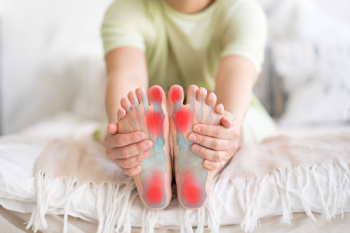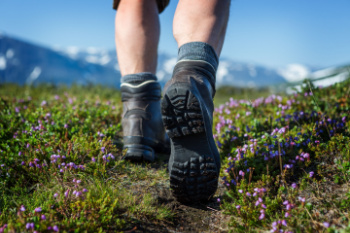Items filtered by date: November 2024
Reminder: When Was the Last Time...?
Exercises for Rheumatoid Arthritis in the Feet

Rheumatoid arthritis, or RA, can cause stiffness, swelling, and pain in the feet, making it difficult to move and walk comfortably. Specific exercises can help improve flexibility, and strength, and reduce discomfort. Gentle stretching exercises, such as toe flexes and ankle rotations, can increase joint mobility and ease tension in the foot. Strengthening exercises, like towel scrunches and marble pickups, engage the small muscles in the feet, promoting stability and supporting proper foot function. In addition, calf stretches can relieve tension in the lower legs and help reduce pressure on the feet. Low-impact activities, such as swimming or cycling, are also beneficial for improving circulation and overall joint function without putting undue stress on the feet. If you have any type of foot arthritis, it is suggested that you contact a podiatrist who can offer effective relief and management tips.
Arthritis can be a difficult condition to live with. If you are seeking treatment, contact one our of podiatrists from The Foot and Ankle Specialists. Our doctors can provide the care you need to keep you pain-free and on your feet.
Arthritic Foot Care
Arthritis is a joint disorder that involves the inflammation of different joints in your body, such as those in your feet. Arthritis is often caused by a degenerative joint disease and causes mild to severe pain in all affected areas. In addition to this, swelling and stiffness in the affected joints can also be a common symptom of arthritis.
In many cases, wearing ill-fitting shoes can worsen the effects and pain of arthritis. Wearing shoes that have a lower heel and extra room can help your feet feel more comfortable. In cases of rheumatoid arthritis, the arch in your foot may become problematic. Buying shoes with proper arch support that contour to your feet can help immensely.
Alleviating Arthritic Pain
- Exercises that stretch the foot can prevent further pain and injury and increase mobility
- Most of the pain can be alleviated with anti-inflammatory drugs, heat, and topical medications
- Massages can help temporarily alleviate pain.
It is best to see your doctor for the treatment that is right for your needs and symptoms. Conditions vary, and a podiatrist can help you determine the right method of care for your feet.
If you have any questions, please feel free to contact our offices located in Houston and Deer Park, TX . We offer the newest diagnostic tools and technology to treat your foot and ankle needs.
Ankle Sprains in Football

Ankle sprains are a common injury in soccer, often resulting from sudden changes in direction or awkward landings. These injuries typically occur when the ligaments that support the ankle stretch or tear, leading to pain and instability. Symptoms of an ankle sprain include swelling, bruising, tenderness, and difficulty bearing weight on the affected foot. Recovery time varies depending on the severity of the sprain. Mild cases may heal within a few weeks, while more severe injuries could require several months for full recovery. Relief usually involves rest, compression, and elevation to reduce swelling and pain. In some instances, specific foot stretches may be necessary to regain strength and mobility. If you have endured an ankle sprain while playing football, it is suggested that you confer with a podiatrist who can effectively treat this condition and get you back into the game.
Sports related foot and ankle injuries require proper treatment before players can go back to their regular routines. For more information, contact one our of podiatrists of The Foot and Ankle Specialists. Our doctors can provide the care you need to keep you pain-free and on your feet.
Sports Related Foot and Ankle Injuries
Foot and ankle injuries are a common occurrence when it comes to athletes of any sport. While many athletes dismiss the initial aches and pains, the truth is that ignoring potential foot and ankle injuries can lead to serious problems. As athletes continue to place pressure and strain the area further, a mild injury can turn into something as serious as a rupture and may lead to a permanent disability. There are many factors that contribute to sports related foot and ankle injuries, which include failure to warm up properly, not providing support or wearing bad footwear. Common injuries and conditions athletes face, including:
- Plantar Fasciitis
- Plantar Fasciosis
- Achilles Tendinitis
- Achilles Tendon Rupture
- Ankle Sprains
Sports related injuries are commonly treated using the RICE method. This includes rest, applying ice to the injured area, compression and elevating the ankle. More serious sprains and injuries may require surgery, which could include arthroscopic and reconstructive surgery. Rehabilitation and therapy may also be required in order to get any recovering athlete to become fully functional again. Any unusual aches and pains an athlete sustains must be evaluated by a licensed, reputable medical professional.
If you have any questions please feel free to contact our offices located in Houston and Deer Park, TX . We offer the newest diagnostic and treatment technologies for all your foot and ankle needs.
How Weight Can Affect Your Feet

Carrying excess weight can significantly impact your feet, leading to a variety of foot-related problems. Extra body weight places added pressure on the feet, especially on the joints, tendons, and ligaments, which can lead to discomfort, inflammation, and overuse injuries. Conditions such as plantar fasciitis, heel spurs, and arthritis are often more prevalent in people with higher body weight. Obesity is also linked to lower arches and pronated foot posture, which further increases stress on the feet and contributes to pain. A podiatrist can recommend supportive footwear, prescribe custom orthotics, and suggest specific exercises to alleviate pain and prevent further damage. Additionally, this foot doctor can monitor your foot health and offer guidance on lifestyle changes that could lessen strain on the feet. If you have foot problems that may be related to carrying extra weight, it is suggested that you schedule an appointment with a podiatrist for an exam and treatment.
The more you weigh, the harder your feet must work to support your body. If you’re an obese individual and are concerned about your feet, contact one our of podiatrists from The Foot and Ankle Specialists. Our doctors can provide the care you need to keep you pain-free and on your feet.
Obesity and Your Feet
People who are overweight are putting more pressure on their ankles, knees, and hips as well as their feet. This unfortunately can lead to variety of different issues.
Problems & Complications Stemming from Obesity
- When the body is overweight, it tries to compensate by changing the way that it moves. An obese person may lean forward and put extra weight on the wrong part of the foot. This puts unnecessary stress on the feet.
- Obese people are also more likely to develop type II diabetes which is a condition that causes a lot of foot problems. People with diabetes often don’t feel the cuts and sores that they may have on their feet, which can lead to more complicated and severe issues.
- Plantar fasciitis is another foot condition that can be caused by obesity. Plantar fasciitis is an inflammation of the tissue along the bottom of the foot, which causes pain and stiffness while walking and climbing stairs.
If you have any questions, please feel free to contact our offices located in Houston and Deer Park, TX . We offer the newest diagnostic and treatment technologies for all your foot care needs.
Tips on Finding the Right Hiking Boots

Choosing the right hiking boots is important for your foot health and comfort on the trails. Hiking can put a lot of stress on your feet, especially if you are carrying a heavy pack or are hiking on uneven terrain. The proper hiking boots provide the necessary support, stability, and cushioning to reduce the risk of foot pain, blisters, and even long-term injuries like plantar fasciitis or tendonitis. When selecting hiking boots, it is important to consider the type of hiking you plan to do. Lightweight boots may be suitable for shorter day hikes on well-maintained trails. For more challenging terrain or longer backpacking trips, midweight or heavy-duty boots provide better ankle support and protection from rough surfaces. Getting the right fit is equally important as boots that are too tight or too loose can lead to foot or ankle pain and injury. A podiatrist can help by assessing your foot’s structure and gait in order to determine which boots or orthotics will provide the best fit and support. If you have foot problems as a result of hiking, it is suggested that you schedule an appointment with a podiatrist.
It is important to find shoes that fit you properly in order to avoid a variety of different foot problems. For more information about treatment, contact one our of podiatrists from The Foot and Ankle Specialists. Our doctors will treat your foot and ankle needs.
Proper Shoe Fitting
Shoes have many different functions. They cushion our body weight, protect our feet, and allow us to safely play sports. You should always make sure that the shoes you wear fit you properly in order to avoid injuries and deformities such as: bunions, corns, calluses, hammertoes, plantar fasciitis, stress fractures, and more. It is important to note that although a certain pair of shoes might be a great fit for someone else, that doesn’t mean they will be a great fit for you. This is why you should always try on shoes before buying them to make sure they are worth the investment. Typically, shoes need to be replaced ever six months to one year of regular use.
Tips for Proper Shoe Fitting
- Select a shoe that is shaped like your foot
- Don’t buy shoes that fit too tight, expecting them to stretch to fit
- Make sure there is enough space (3/8” to ½”) for your longest toe at the end of each shoe when you are standing up
- Walk in the shoes to make sure they fit and feel right
- Don’t select shoes by the size marked inside the shoe, but by how the shoe fits your foot
The shoes you buy should always feel as good as they look. Shoes that fit properly will last longer, feel better, and improve your way of life each day.
If you have any questions, please feel free to contact our offices located in Houston and Deer Park, TX . We offer the newest diagnostic and treatment technologies for all your foot care needs.

